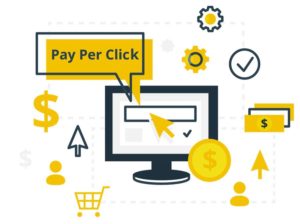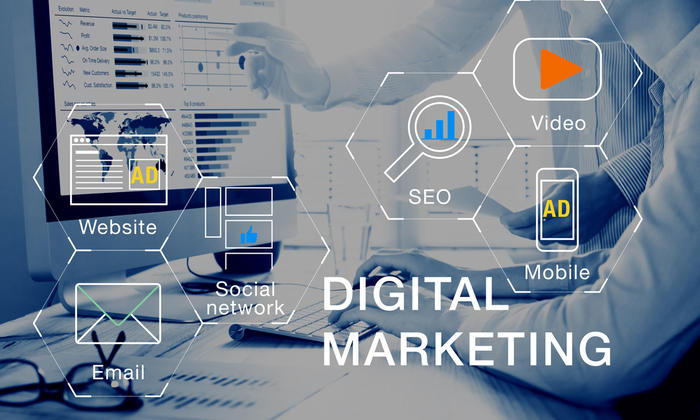Digital marketing has been on the rise since the internet’s inception in the 1990s. Businesses around the world are starting to recognize the internet’s influence, with 53.6 percent (4.1 billion) of the world’s population having access to it. They are putting in the necessary effort to transfer their marketing strategies to the internet.
We hear a lot about digital media and online marketing these days and companies that invest in these marketing platforms are expanding digitally while still making money. When we talk about digital marketing, we think about a lot of things: what is it, how to get started, which platforms to use, and how to be successful.
Fortunately, you’ve come to the right place. In this article, we’ll learn what digital marketing is and what digital marketing elements you can use in your plan.
What Is Digital Marketing?
Digital marketing, also known as online marketing, is the promotion of products across the internet and other means of digital communication in order to communicate with potential customers. As a marketing channel, this involves not only email, social media, and web-based advertisements, but also text and multimedia communications.
Both online and offline, digital marketing is used. Television marketing, phone marketing, and radio marketing are examples of offline digital marketing. Though offline digital marketing was effective in the 1990s, online digital marketing has now become the real deal. Businesses can reach consumers in a number of ways through online digital marketing, depending on their marketing plan and budget.
Components of digital marketing usually include:
- Your Website
- Search engine optimization (SEO)
- Pay-per-click advertising (PPC)
- Content marketing
- Social media marketing
- Your Website:
Your website is, first and foremost, the online portal of your business. It’s a place where you can market yourself as you want and make real connections with your target audience. At the end of the day, this is where you want to guide all of your traffic. All of your online marketing activities will lead back to your website, where you can kindly guide visitors through your sales funnel and convert them to customers. Your website is the face of your business.
Ensure that your official website meets the following requirements:
- The website must be easy to navigate.
- Should talk about your company or brand.
- Include all the contact details.
- The design of your website should be professional, safe, and simple to use.
- The website should be mobile-friendly.
- Specific pages for and of your services/items should be created to help you keep track of them.

- Search Engine Optimization(SEO):
Many users and customers begin their journey by searching for the goods and services they need on search engines. So, are you being noticed while people are searching for your company’s services or products? SEO is a keyword-driven strategy. It is used to improve the quality of your website in order for it to rank higher in search engine results pages (SERPs). According to a recent expert study, 71% of consumers begin their purchasing journey on search engines. Higher search engine rankings mean more organic traffic and exposure for your website.
To generate eligible leads to a website, SEO can be approached in a variety of ways:
(i) On-page SEO
(ii) Off-Page SEO
(iii) Technical SEO

- Social Media Marketing:
When we talk about digital marketing, we have to include social media as a non-negotiable and inevitable component. When opposed to every other online person, everybody is becoming more involved on social media sites, making it simple to reach and communicate with your customers.
The use of social media to promote your brand’s content or company and connect with your target audience is known as social media marketing. It can be used to increase the number of visitors to your website. Social networking platforms such as Facebook, Instagram, Pinterest, Twitter, and LinkedIn have large followings, allowing marketers to engage with their target customers on a larger scale. Social media is powerful because it allows you to directly communicate with your consumers and learn what they think about your products/services, allowing you to continue to evolve.

- Pay Per Click (PPC) advertising:
Pay-per-click (PPC) ads are a great way to stay visible in search results as you work on improving your organic rankings with SEO. If you want to improve your rankings quickly, PPC will start driving eligible leads to your site as soon as your ads go live — and it’s a cost-effective choice for businesses of all sizes. Since PPC traffic is entirely charged, it varies from SEO.
For example, Google Adwords will place you at the top of Google Search, but any click created by your PPC campaign will cost you money, regardless of whether that click converts into a lead or not.
However, the advantage of this is that you will see immediate results, while SEO, though free, will take time to work. You can use PPC to target people based on demographics, location, and even device type. These targeting options, combined with PPC’s low cost, make it an important part of a successful digital marketing strategy.

- Content Marketing:
This category encompasses a wide range of strategies, including YouTube videos, blog articles, Instagram updates, and more. Since it allows you to offer useful content to your audience, content marketing is an integral part of digital marketing. Content marketing is the process of creating content and posting it on various online sites in order to increase brand recognition, generate leads, increase traffic, attract more customers, or create a reputation. Specifically, this marketing is done indirectly to gain consumers’ attention through the material, rather than explicitly promoting the company. Content marketing relies heavily on high-quality content. Quality content enables you to target keywords relevant to your company and respond to searchers’ questions, resulting in higher rankings.
Conclusion:
Create a content-rich website while keeping SEO in mind, and use social media to communicate with your customers.
Improve customer interaction by following these steps. Create a database of confirmed contacts using the email addresses you’ve collected from newsletter signups. After that, you can use this list for potential marketing and email campaigns.
#SEO #
Contact us: 9015023796
Visit us: www.omsoftsolution.com

